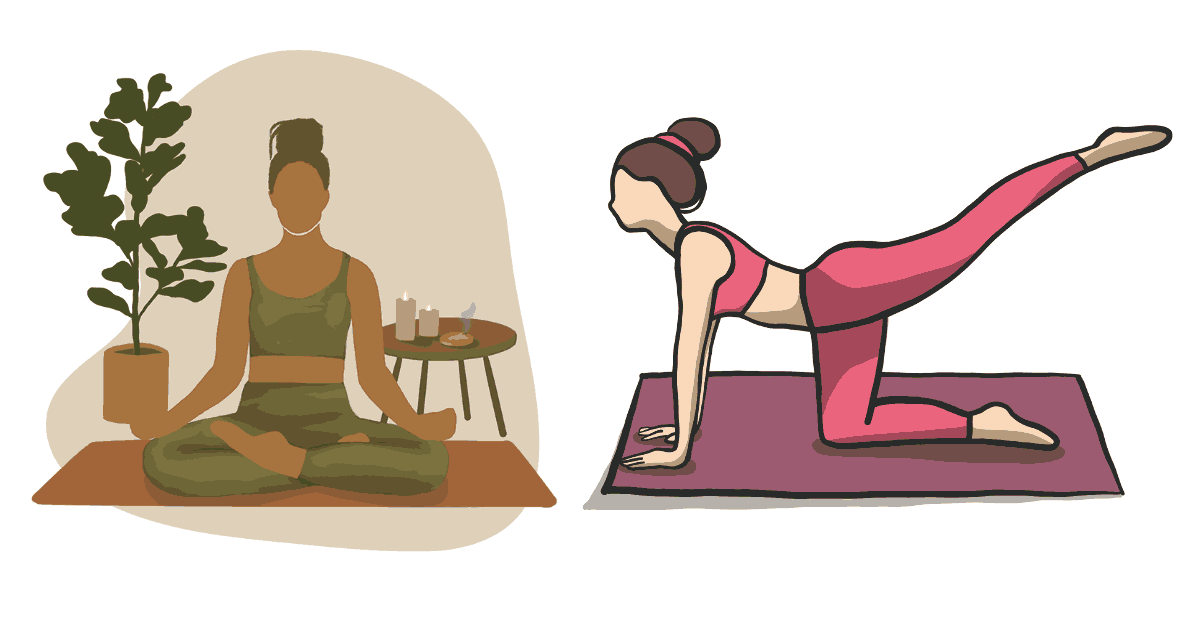Introduction
Would you like to enhance your heart health, reduce stress, and increase flexibility at the same time? If this sounds appealing to you, then keep reading and discover the amazing advantages of practicing yoga for cardiovascular fitness. In this article about yoga for heart health, you will learn more.
Yoga is an ancient practice that has been around for thousands of years, but its positive impacts on heart health are only recently being fully understood and appreciated by the medical community. The key takeaway is that through a combination of physical postures, breathwork, and meditation, yoga can be a powerful tool for supporting a healthy heart and overall well-being.
In this comprehensive guide, we’ll dive deep into the science behind how yoga improves cardiovascular health. You’ll learn specific yoga poses and routines designed to reduce heart disease risk factors like high blood pressure, cholesterol, and stress levels. Plus, we’ll provide practical tips to help you build a safe and sustainable yoga practice tailored to your needs.
The Powerful Mind-Body Connection
At its core, yoga is a mind-body practice that combines physical postures (asanas), breathwork (pranayama), and meditation/mindfulness techniques. This holistic approach is what makes yoga so effective for improving heart health on multiple levels.
The physical component gets your body moving, increases blood flow and circulation, burns calories, and builds strength and flexibility. But it’s the mindfulness aspect of yoga that really sets it apart.
Through focused breathing exercises and meditation, yoga helps activate the parasympathetic nervous system – the “rest and digest” mode that counteracts the fight-or-flight stress response. Chronic stress is a major risk factor for heart disease, so anything that can reduce stress provides huge cardiovascular benefits.
“Yoga helps you to rediscover a sense of completeness in your life, in which you don’t feel disconnected or disintegrating. When you feel wholeness, feelings of disappointment frequently disappear.” – B.K.S. Iyengar, founder of Yoga
So by syncing movement with breath and present-moment awareness, yoga creates a powerful mind-body connection that enhances every aspect of heart health.

How Yoga Improves Cardiovascular Health: Yoga for heart health
Now that we understand the mind-body dynamics at play, let’s look at some of the specific ways yoga can give your heart a boost:
- Reduces blood pressure: Many studies have found that regularly practicing yoga can help lower high blood pressure levels. This is due to improved blood circulation, reduced stress hormones like adrenaline and cortisol, and activation of the parasympathetic nervous system.
- Improves cholesterol levels: Yoga’s combination of physical activity and stress reduction has also been shown to improve cholesterol profiles. It may increase “good” HDL cholesterol while lowering “bad” LDL cholesterol and triglycerides.
- Enhances blood flow and circulation: Certain yoga poses and sequences get blood pumping through the body more efficiently by using gravity, muscle contractions, and breathwork. This delivers more oxygen to cells and organs while removing waste products.
- Burns calories and boosts metabolism: While not as intense as aerobic exercise, active and vigorous yoga styles can burn a decent amount of calories. This helps support a healthy weight, which takes pressure off the heart.
- Reduces inflammation: Chronic inflammation is a key driver of many diseases, including heart disease. The anti-inflammatory effects of yoga come from reduced stress, improved oxygenation, and gentle movements that increase joint mobility.
Understanding the Science: A Closer Look
As you can see, the cardiovascular benefits of yoga are numerous and powerful. But how exactly does science back up these claims? Let’s take a closer look at some of the most well-researched and evidence-based aspects of yoga for heart health.
Different Yoga Style’s Impacts
While all forms of yoga are beneficial to some degree, certain styles lend themselves better towards cardiovascular fitness. Here’s a quick overview:
– Hatha Yoga: This is one of the most popular and gentle styles, combining basic physical postures with breathwork and meditation. It’s a great starting point for building strength, flexibility, and stress resilience.
– Iyengar Yoga: This meticulous style that focuses on precise physical alignment and the use of props. Its emphasis on getting poses “just right” builds body awareness and balance.
– Vinyasa/Power Yoga: These intense, faster-paced forms incorporate a continuous series of flowing movements synced with breath. They tend to be more aerobic and raise the heart rate more.
– Restorative Yoga: This therapeutic style uses a variety of props to support the body in relaxing, passive poses. It’s excellent for relieving stress and promoting healing.
– Hot Yoga: These room temperature classes (think 100°F+) create a vigorous internal and external heating effect that makes muscles more pliable while raising heart rate.
While each style offers its own unique benefits, combining elements of different approaches is ideal for an optimal “yoga cardio” workout.
The Power of Breathwork
No discussion of yoga for heart health would be complete without exploring the role of breathwork. Yogic breathing techniques called “pranayama” are a core component of the practice.
By consciously controlling the breath through specific patterns and rates of inhalation/exhalation, pranayama can have profound physiological effects. It activates the parasympathetic nervous system, increases oxygen delivery, removes metabolic waste more efficiently, and even impacts gene expression.
Some of the most well-known and beneficial breathwork practices for heart health include:
– Nadi Shodhana (Alternate Nostril Breathing)
– Bhramari (Bee Breath)
– Kapalabhati (Skull Shining Breath)
– Ujjayi (Victorious Breath)
Practicing pranayama in combination with asanas is a one-two punch that optimizes blood flow, reduces stress/inflammation, and promotes cardiac fitness.

How Yoga Manages Key Risk Factors
In addition to the direct cardiovascular improvements we’ve covered so far, yoga also helps manage many of the key lifestyle risk factors that contribute to heart disease:
- Excess Weight/Obesity: While not as high-intensity as some cardio workouts, certain vigorous yoga styles like power vinyasa and hot yoga can burn a significant amount of calories and support healthy weight management.
- Chronic Stress: As we’ve discussed, yoga’s combination of physical postures, breathwork, meditation and mindfulness make it one of the best stress-busting practices around. Reduced stress = lower inflammation and improved heart health.
- Sedentary Lifestyle: Any physical activity is better than none when it comes to combating the dangers of an overly sedentary lifestyle. By getting practitioners moving and breathing in mindful ways, yoga helps counteract the risks of being too inactive.
- Poor Sleep: The relaxation benefits of yoga, particularly restorative styles, have been shown to improve sleep quality. Since poor sleep is linked to higher risks of heart disease, yoga can provide an extra layer of protection.
- Smoking/Alcohol Abuse: While not directly treating addictive behaviors, yoga’s mindfulness components can increase self-awareness and provide healthy outlets for managing cravings and negative emotions that drive addiction.
So in many ways, simply practicing yoga consistently can be a powerful form of heart disease prevention – without requiring any fancy equipment or gear.
My Top 10 Yoga Poses for a Healthy Heart
Now that you understand all the incredible ways yoga supports cardiovascular health, you’re probably eager to get started. This next section breaks down ten of my absolute favorite heart-healthy yoga poses, including explanations and tips on how to do them safely and effectively.
A quick word on safety: While yoga is generally low-impact and safe for most people, it’s still important to check with your doctor before starting any new exercise program – especially if you have an existing heart condition or other health concerns. Some stances may need to be ignored or changed.
With that said, let’s get to the yoga poses!
1. Mountain Pose (Tadasana)
We’ll start with one of the most fundamental poses that focuses on foundation, alignment, and stable breathing:
– Stand with feet hip-width apart, arms by your sides, shoulders relaxed
– Engage your core and thigh muscles by drawing your navel in towards your spine
– Keep equal weight distribution through the soles of your feet
– Look straight ahead and breathe deeply through your nose
This grounding pose establishes a strong, upright base to support more active postures. It also promotes body awareness and steady breathing from the start.
2. Standing Forward Bend (Uttanasana)
Next, we’ll gently move into a mild inversion that reverses the effects of gravity:
– From mountain pose, hinge at the hips to fold your torso over your legs
– Keep a slight bend in the knees to prevent
3. Extended Triangle Pose (Utthita Trikonasana)
This standing lateral stretch gets your whole body integrated while improving balance and concentration:
– From mountain posture, step one foot back around 3-4 feet.
– Engage your core, then hinge at the hips to reach your torso forward and down
– Stretch your top arm towards the ceiling and stack your shoulders
– Use a block under your bottom hand if needed to prevent rounding the spine
– Look up towards your top hand and breathe deeply into your entire side body
4. Seated Forward Bend (Paschimottanasana)
Here’s a beautifully restorative forward fold that stretches the entire backside of the body:
– Sit on the floor, legs out in front of you, feet flexed.
– Lengthen your spine, then walk your hands forward as far as feels comfortable
– Use a strap or towel around your feet to modify if hamstrings are tight
– Relax your head and neck towards your shins and breathe into your lower back
5. Bridge posture (Setu Bandhasana)
This invigorating backbend is an excellent way to stretch the front body and open up the chest/heart area:
– Lie on your back, knees bent and feet flat on the floor near your sitting bones
– Press your arms and feet into the floor to lift your hips up towards the ceiling
– Interlace your hands underneath your back and lift your chest up and towards your chin
– Breathe deeply into your chest and upper abdomen
6. Camel Pose (Ustrasana)
For those with good flexibility, camel is another fantastic heart-opening backbend:
– Kneel on the floor, hip width apart, your thighs perpendicular to the ground.
– Reach your hands back one at a time to grab your heels with fingers pointing down
– Press your hips forward, lift your chest up and allow your head to drop back
– Look for a feeling of expansion across your whole chest/abdominal area
7. Supine Twist (Supta Matsyendrasana)
Twists are very therapeutic for the spine, internal organs, and circulation. This supine twist variation is extremely gentle:
– Lie on your back, hugging both legs to your chest.
– Extend your arms out in a “T” shape and look over your right shoulder
– Slowly lower both bent legs over to the left side, keeping your shoulders squared to the front
– Switch sides after 5-10 breaths.
8. Legs-Up-the-Wall Pose (Viparita Karani)
This restorative inversion takes pressure off the heart and allows fresh blood to flow back from the legs:
– Sit sideways with your left hip against a wall, then swing your legs up the wall
– Walk your shoulders away from the wall to allow your sitting bones to press into the floor
– Relax your arms in any comfortable position and breathe slowly and deeply
– Stay here for 5-15 minutes, or as long as feels good
9. Corpse Pose (Savasana)
No yoga practice is complete without this final resting posture designed for total mind-body integration:
– Lie on your back with your feet flopped open and arms by your sides, palms facing up
– Allow your whole body to completely release any muscle tension and relax onto the floor
– Breathe naturally and bring your attention inward to your heartbeat and steady breath
– Observe any thoughts that arise with non-judgement, then let them go
10. Alternate Nostril Breathing (Nadi Shodhana)
We’ll finish with a powerful breathwork technique for balancing the mind-body system:
– Begin in a comfortable seated posture with a straight spine.
– Close your right nostril with your thumb, then slowly inhale through your left nose.
– Close your left nostril with your ring finger, release your thumb and exhale out the right side
– Inhale right, close both nostrils and hold briefly, then release the left nostril to exhale
– Continue this alternating pattern for 5-10 rounds, allowing your breath to become smooth and rhythmic
No matter which poses or breathwork exercises you choose, the key is to practice regularly. I recommend aiming for at least 2-3 sessions per week of about 30-60 minutes each for optimal heart health benefits.

A Beginner-Friendly Routine You Can Do at Home
For those who are brand new to yoga, the idea of stepping into a studio class can feel intimidating. Not to worry! You can absolutely get started building a heart-healthy yoga routine from the comfort of your living room.
Here’s a simple, beginner-friendly sequence you can follow a few times per week:
– Start with 5 minutes of breath awareness in a comfortable seated position
– Move through 5-10 rounds of cat/cow pose to warm up your spine
– Take 5-10 slow sun salutations, flowing with your breath
– Hold some of the standing poses like mountain, forward fold, and triangle for 5 breaths each
– Add a few seated and supine poses like staff pose, supine twist, and legs up the wall
– Finish with at least 5 minutes in corpse pose to integrate your practice
As you start to feel more comfortable, you can adjust this routine by adding new poses or trying different breathwork exercises. Building up slowly and listening to your body is the way to go.
You can also find a wealth of high-quality, free yoga videos and apps to guide you through full-length classes at home. This allows you to learn proper form and alignment from experienced instructors.
Whichever approach you take, making yoga a consistent habit is key for experiencing all the amazing heart health benefits.
Making Yoga a Way of Life
Speaking of consistency, it’s important to remember that yoga is much more than just an exercise routine. It’s a holistic way of living and being that can support heart health in so many ways.
In addition to your physical practice, here are some tips for bringing more “yoga” into your everyday life:
– Practice mindfulness and breathwork during moments of stress
– Eat a balanced, anti-inflammatory, plant-forward diet
– Take breaks during the day to stretch, move, and reset your posture
– Find healthy ways to cope with difficult emotions through journaling or talking to a friend
– Get enough high-quality sleep by winding down before bed with relaxing yoga poses or meditations
The more you embrace the full lifestyle, the more your heart will thank you!
When to Consult a Doctor
While yoga is generally considered a safe, low-impact form of exercise, there are some situations where speaking to a doctor or trained professional first is wise. Immediately consult your doctor for medical advice if the following occurs:
– You have an existing heart condition, high blood pressure, or are taking cardiac medications
– You’ve had recent surgery or are recovering from an injury
– You have severe osteoporosis, glaucoma, or other medical issues
– You are pregnant or recently gave birth.
An experienced yoga instructor can also provide guidance on which poses to avoid or modify based on your individual needs and limitations. Honor your body by not pushing too hard too fast.

Conclusion
By now, I hope you have a newfound appreciation for the transformative power of yoga when it comes to promoting heart health and overall well-being. Whether you’re looking to prevent heart disease down the road or support healing from an existing cardiac condition, yoga is an incredible complementary practice.
At its essence, yoga teaches us to become more intimately connected to ourselves – our physical bodies, our thoughts, our emotions, our spirit. From this place of inner harmony and acceptance, it’s much easier to make choices that nurture our hearts.
So consider this your invitation to step onto the yoga mat and begin your heart-healthy journey. All it takes is a little patience, an open mind, and the courage to prioritize self-care. Your heart will be forever grateful.
FAQs:
Is yoga considered an aerobic exercise that can improve cardiovascular fitness?
While certain vigorous styles of yoga like power vinyasa and hot yoga can provide an aerobic workout, most forms of yoga are not technically considered aerobic exercise. However, research shows that yoga's combination of physical postures, breathwork, and meditation provides a host of benefits for heart health - even if the heart rate doesn't get as elevated as it would during running or cycling. Yoga improves circulation, lowers blood pressure, reduces inflammation, burns calories, and promotes healthy stress management.
Are there any yoga poses that should be avoided for those with heart conditions?
Yes, some poses may need to be modified or avoided entirely if you have a heart condition or are at high risk for heart disease. Poses that drastically change body position from standing to inverted can cause drops in blood pressure. Backbends that compress the abdomen may put strain on the heart. And any poses that involve holding the breath for extended periods could be risky. It's best to consult a doctor and experienced yoga instructor before trying advanced poses.
How often should I practice yoga to see benefits for heart health?
Most experts recommend practicing yoga at least 2-3 times per week for 30-60 minutes to start seeing improvements in cardiovascular health markers like blood pressure, cholesterol levels, and resting heart rate. Ideally, you'd practice 4-5 times per week. Consistency is key, as the benefits of yoga compound over time as it becomes a regular lifestyle habit.
Is heated or hot yoga better for heart health compared to other styles?
While the added heat and humidity in Bikram or hot yoga classes does tend to raise the heart rate and calorie burn more, these types of classes may not be appropriate for everyone - especially those with heart conditions, high blood pressure, or heat sensitivity. Generally, movement-focused styles like vinyasa or power yoga that get your heart pumping while emphasizing breathwork could provide the ideal balance for supporting cardiovascular fitness.
Can yoga alone be enough physical activity for a healthy heart?
While an exclusive yoga practice can certainly provide immense benefits for heart health and reduce many cardiac risk factors, most experts still recommend incorporating additional aerobic activities like walking, swimming, or cycling. The combination of yoga's mindfulness and stress relief with more vigorous cardio exercise appears to be the ideal recipe for optimal heart health. Yoga acts as the perfect complement to other physical activities.




